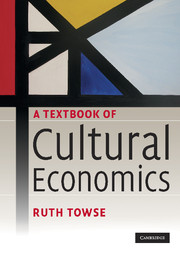Book contents
- Frontmatter
- Contents
- List of figures
- List of tables
- List of boxes
- List of abbreviations
- Preface
- Part I General issues in cultural economics
- Introduction
- 1 Introduction to cultural economics
- 2 Economic profile of the cultural sector
- 3 Markets for cultural goods and services
- 4 Economic organisation of the creative industries
- 5 Production, costs and supply of cultural goods
- 6 Consumption of cultural goods and services
- 7 Welfare economics and public finance
- Part II The ‘traditional’ economics of the arts and heritage
- Part III Artists' labour markets and copyright
- Part IV The creative industries
- Part V Conclusion and exercises and problems
- References
- Index
2 - Economic profile of the cultural sector
- Frontmatter
- Contents
- List of figures
- List of tables
- List of boxes
- List of abbreviations
- Preface
- Part I General issues in cultural economics
- Introduction
- 1 Introduction to cultural economics
- 2 Economic profile of the cultural sector
- 3 Markets for cultural goods and services
- 4 Economic organisation of the creative industries
- 5 Production, costs and supply of cultural goods
- 6 Consumption of cultural goods and services
- 7 Welfare economics and public finance
- Part II The ‘traditional’ economics of the arts and heritage
- Part III Artists' labour markets and copyright
- Part IV The creative industries
- Part V Conclusion and exercises and problems
- References
- Index
Summary
This chapter investigates various aspects of building an economic profile of the cultural economy and introduces a theme that is taken up, one way or another, in every chapter of the book, namely the role of the private and public sectors in the provision of cultural or creative goods and services. Though the term ‘creative economy’ has become increasingly used, it nevertheless typically covers a broader scope of industries than the arts, heritage and cultural industries as studied in cultural economics, including, as in the Creative Economy Report 2008 published by UNCTAD (2008), scientific and technical – even economic – creativity. This is still emerging terminology and there is as yet no one settled definition of the scope of the term. To make matters more specific, therefore, the term ‘cultural sector’ is used here unless specifically talking about the creative industries. The chapter also introduces the use of empirical data to present a description of the cultural sector: data sources and descriptive statistics, and how the size of the sector is measured.
In the chapter, we look at several related topics that provide an economic profile of the sector: the role of public and private ownership; cultural policy and public finance; statistics on the cultural sector; and, finally, measuring the size of the cultural sector in countries using published data and national income accounting, international trade in cultural products and international comparisons of the cultural sectors in several countries, rounding off with a discussion of the use and abuse of statistics.
- Type
- Chapter
- Information
- A Textbook of Cultural Economics , pp. 26 - 50Publisher: Cambridge University PressPrint publication year: 2010



